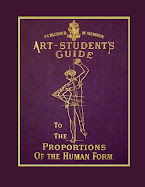

It is titled The Human Head and has 64 illustrations in the manner made famous by Prof. Bail's system of Drawing Charts which were widely adopted by schools throughout the country to teach drawing to young students.
The Drawing Charts proceeded from drawing lines to drawing angles, then drawing curves, double curves, using the squares and angles to draw dwellings, drawing leaves, circles, ellipses and thenusing all of the above to draw simple, then more complicated ornaments. His goal was to train American students in the drawing arts so that they could become ornamental designers and have productive careers. His argument for the study of drawing was not very different from the argument people make today about improving American education. He made this argument about the teaching of mechanical drawing:
There is too much guess work in our mechanical operations, that can only be obviated by such instruction as you propose. A great deal of time is wasted in "cutting and fitting," and making things only "about right," when absolute certainty and correctness of plan should have been secured beforehand. There is no form, however complex, that cannot be indicated by drawing in such a manner that an intelligent workman, who is competent to read or, understand drawings, can execute the object represented with absolute certainty. The simple ability to read plans and drawings fit a man for a good position. In fact the foreman of a shop is often the only man able to do this. By leaving our mechanics in this semi-barbarous condition we lose much money and credit, and lower the intellectual and moral condition of our artisans. The more mind a man brings to bear upon his business the more respectable and self-respecting he will become.
The complete text from the Special Report of the Commissioner of Education on the Condition and Improvement of Public Schools in the District of Columbia By United States. Dept. of Education, Henry Barnard, 1870 is here.

The lessons on drawing heads proceed the same way from the simple form, to proportions of the head, to the muscular structure of the head to drawing the head from different angles to incorporating expression and character in the drawing of the head.
There was a preoccupation in the mid-1800s with drawing the head in profile and establishing the angle of the head. this picture illustrates one of Bail's drawings like that. The impact of the theory of physiognomy is discussed in an article titled Life Drawing from Ape to Human: Charles Darwin's Theories of Evolution and William Rimmer's Art Anatomy by Elliott Bostwick Davis




The plates of heads illustrate these subjects:
The Human Skull from the side.
The Human Skull from the front.
The Muscles of the Human Head from the side.
The Muscles of the Human Head from the front.
How to Draw the Mouth.
How to Draw Eyes from the side.
How to Draw Eyes from the front.
How to Draw Ears.
Facial Angles - 4 plates.
The Outline and Proportions of the Human Head in Profile.
The Outline and Proportions of the Human Head from the front.
The Head Looking Down.
The Head Looking Up.
Three-Quarters View of the Head - 2 plates.
Three-Quarters View of the Head looking down - 2 plates.
Three-Quarters View of the Head looking up - 3 plates.
Sample Drawings of Heads Illustrating the Principles of Drawing - 17 plates.
How to Draw a Caucasian.
How to Draw a African.
How to Draw Old Age - 2 plates.
How to Draw Infancy - 2 plates.
How to Draw Sobriety.
How to Draw Laughter - 3 plates.
How to Draw Discontent.
How to Draw Severity.
How to Draw Fright.
How to Draw Anxious Watchfulness.
How to Draw Bodily Fear.
How to Draw Weeping.
How to Draw Terror.
How to Draw Prayer - 2 plates.
How to Draw Innocence.
How to Draw a Misanthrope.
How to Draw Surprise.
How to Draw Great Pain.
How to Draw Rage.
Here is a notation from the Illinois School Journal of 1883 where Prof. Bail is among the judges for a
This is an advertisement from The New York Teacher from 1871 about Bail's Drawing Charts.

An original copy is listed at Amazon.com: The Human Head; a Correct Delineation of the Anatomy, Expressions, Features, Proportions and Positions of the Head and Face
The World Cat Lists it in only 2 libraries, Penn State where it is probably part of The Albert A. Anderson, Jr. and Evelynn M. Ellis Art Education Collection, and Yale where Prof. Bail taught at the Sheffield Scientific School, of Tate College.
Related modern books from Amazon.com:
How to Draw the Human Head: Techniques and Anatomy
Drawing the Human Head (Practical Art Books)
Draw Faces & Expressions
Making Faces: Drawing Expressions For Comics And Cartoons
A copy of The Human Head; a Correct Delineation of the Anatomy, Expressions, Features, Proportions and Positions of the Head and Face
at Amazon.com.
See other posts on drawing books by William Rimmer, John Gadsby Chapman.

















No comments:
Post a Comment